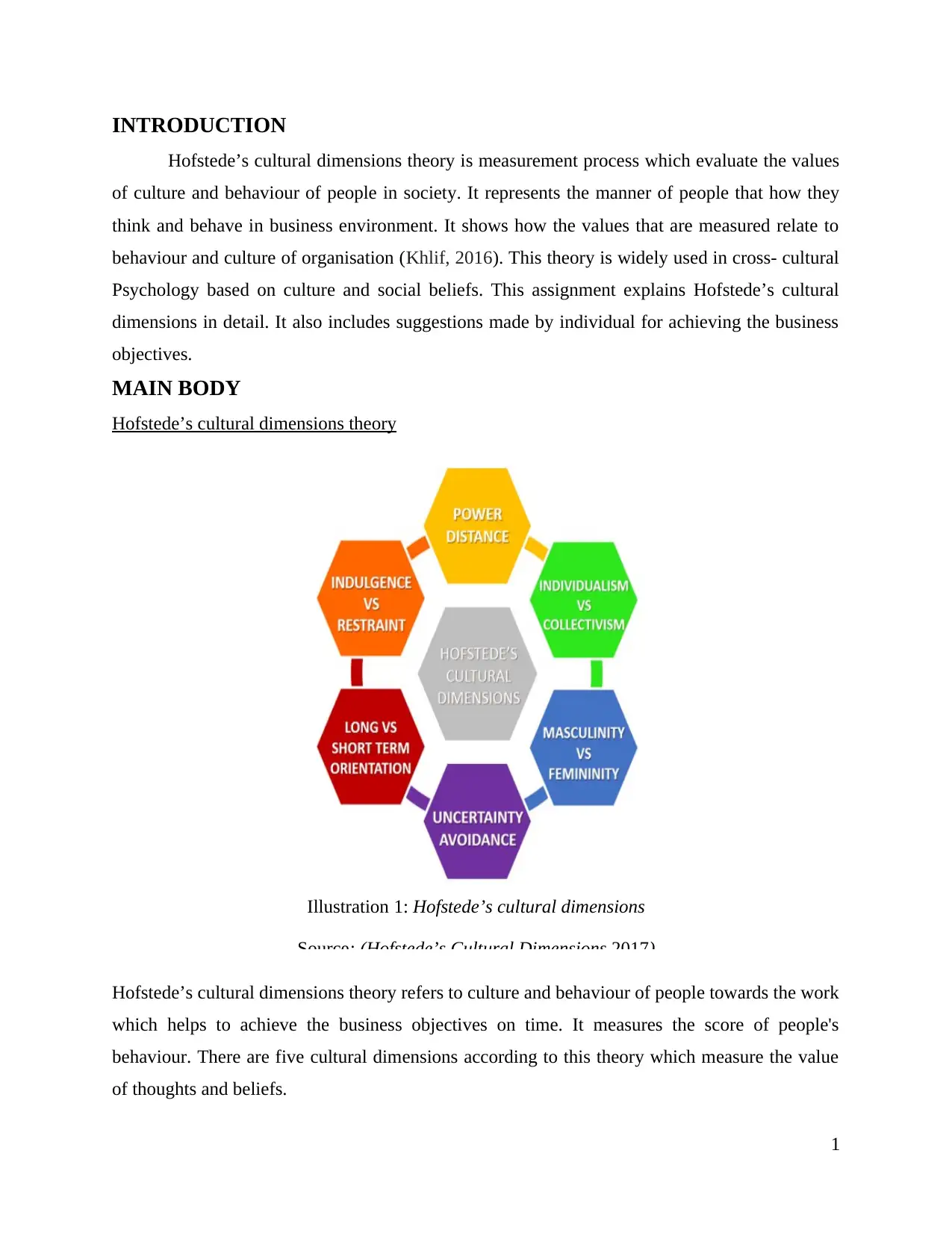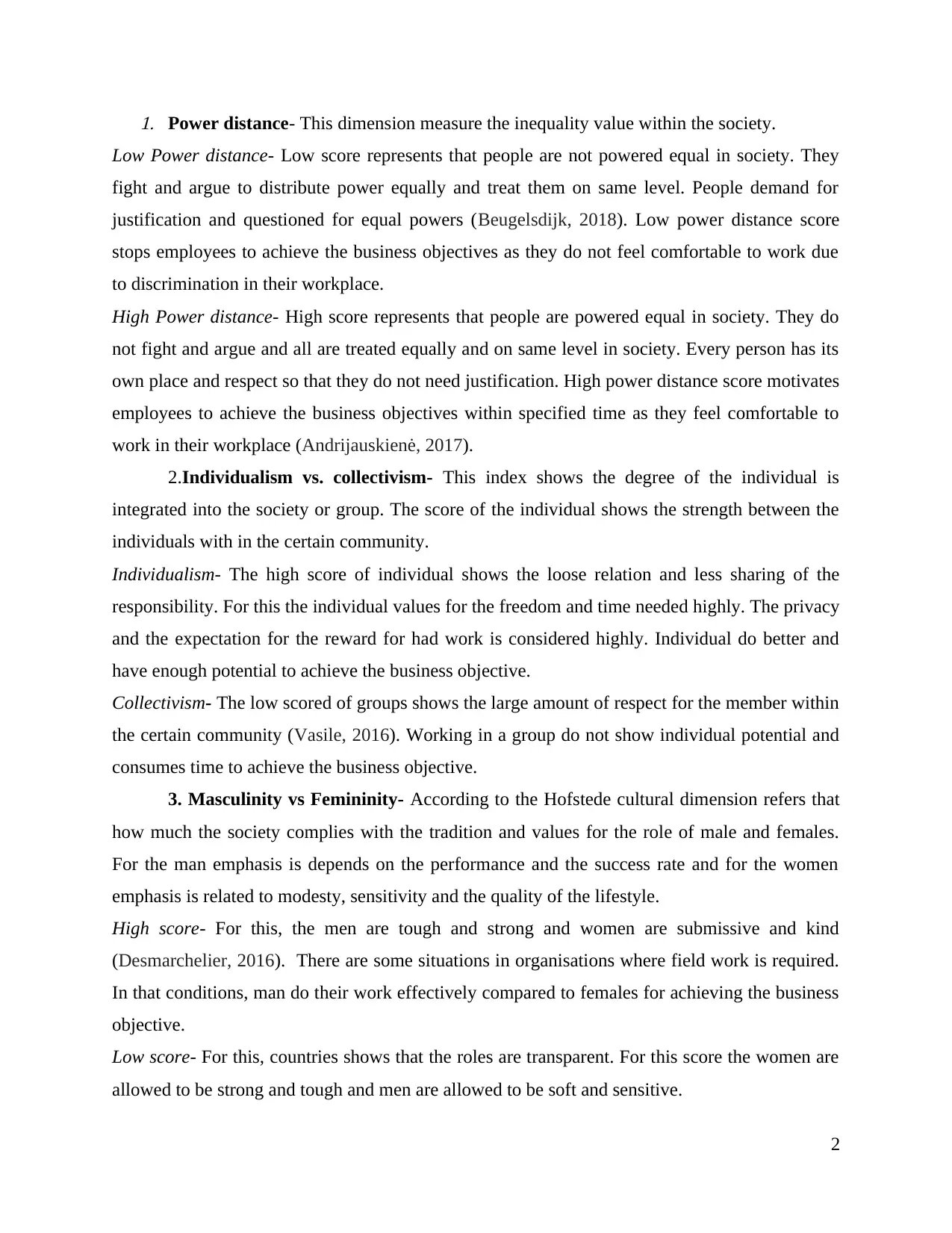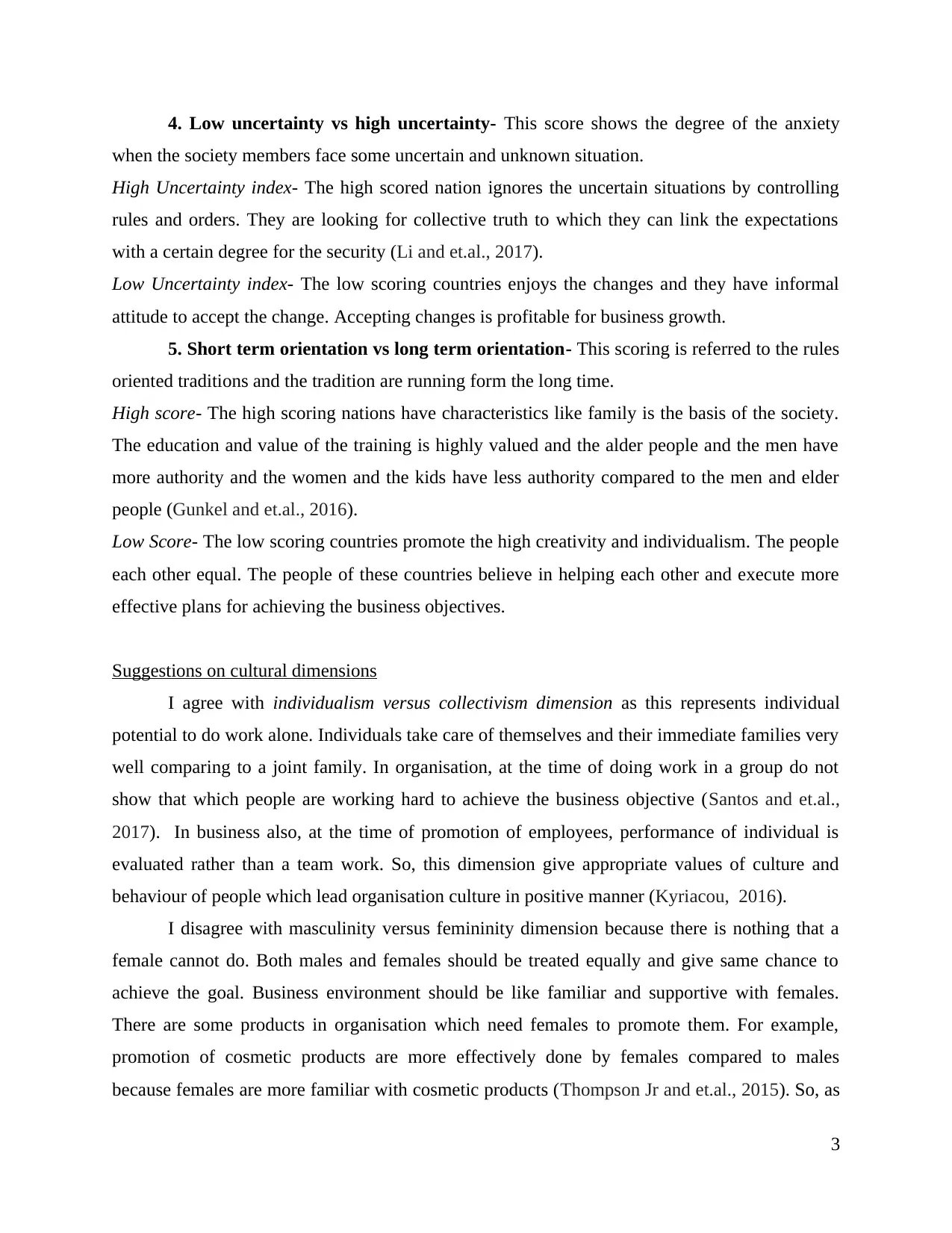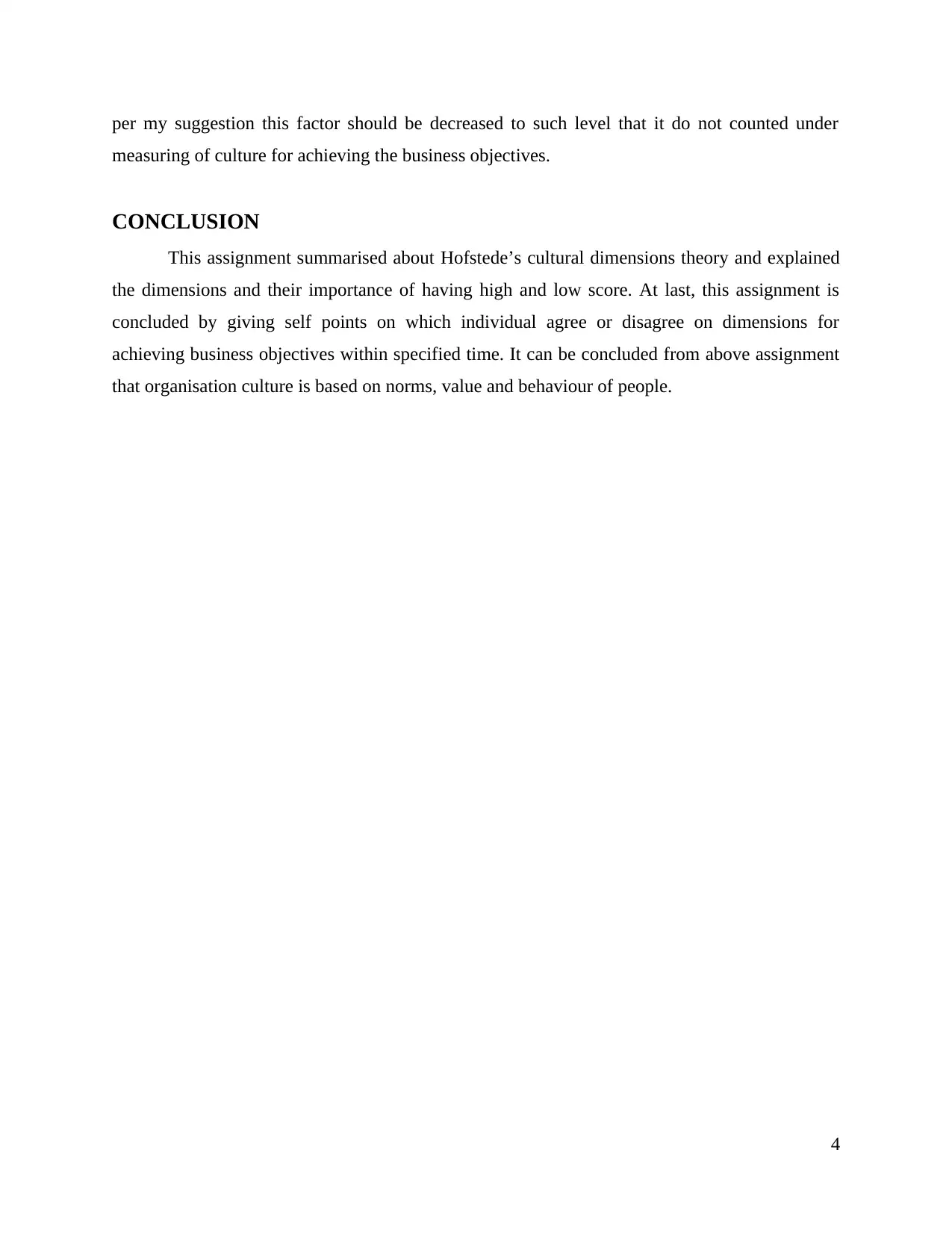Understanding Hofstede's Cultural Dimensions and Their Impact
VerifiedAdded on 2020/11/23
|7
|1546
|250
Report
AI Summary
This report provides a comprehensive overview of Hofstede's cultural dimensions theory, a framework used to understand cultural differences in business environments. It explores the five key dimensions: power distance, individualism vs. collectivism, masculinity vs. femininity, uncertainty avoidance, and long-term orientation. The report delves into the characteristics of each dimension, explaining how they influence workplace dynamics, employee behavior, and the achievement of business objectives. It includes suggestions on how to leverage these dimensions for effective management and organizational success, highlighting individual perspectives on the theory. The report concludes with a summary of the key findings and a reflection on the importance of understanding cultural nuances in a globalized world, emphasizing the impact of these dimensions on organizational culture, norms, values and behavior of people.

STUDY SKILLS
Paraphrase This Document
Need a fresh take? Get an instant paraphrase of this document with our AI Paraphraser

TABLE OF CONTENTS
INTRODUCTION...........................................................................................................................1
MAIN BODY...................................................................................................................................1
Hofstede’s cultural dimensions theory........................................................................................1
Suggestions on cultural dimensions............................................................................................3
CONCLUSION................................................................................................................................4
REFERENCES................................................................................................................................5
INTRODUCTION...........................................................................................................................1
MAIN BODY...................................................................................................................................1
Hofstede’s cultural dimensions theory........................................................................................1
Suggestions on cultural dimensions............................................................................................3
CONCLUSION................................................................................................................................4
REFERENCES................................................................................................................................5

INTRODUCTION
Hofstede’s cultural dimensions theory is measurement process which evaluate the values
of culture and behaviour of people in society. It represents the manner of people that how they
think and behave in business environment. It shows how the values that are measured relate to
behaviour and culture of organisation (Khlif, 2016). This theory is widely used in cross- cultural
Psychology based on culture and social beliefs. This assignment explains Hofstede’s cultural
dimensions in detail. It also includes suggestions made by individual for achieving the business
objectives.
MAIN BODY
Hofstede’s cultural dimensions theory
Hofstede’s cultural dimensions theory refers to culture and behaviour of people towards the work
which helps to achieve the business objectives on time. It measures the score of people's
behaviour. There are five cultural dimensions according to this theory which measure the value
of thoughts and beliefs.
1
Illustration 1: Hofstede’s cultural dimensions
Source: (Hofstede’s Cultural Dimensions 2017)
Hofstede’s cultural dimensions theory is measurement process which evaluate the values
of culture and behaviour of people in society. It represents the manner of people that how they
think and behave in business environment. It shows how the values that are measured relate to
behaviour and culture of organisation (Khlif, 2016). This theory is widely used in cross- cultural
Psychology based on culture and social beliefs. This assignment explains Hofstede’s cultural
dimensions in detail. It also includes suggestions made by individual for achieving the business
objectives.
MAIN BODY
Hofstede’s cultural dimensions theory
Hofstede’s cultural dimensions theory refers to culture and behaviour of people towards the work
which helps to achieve the business objectives on time. It measures the score of people's
behaviour. There are five cultural dimensions according to this theory which measure the value
of thoughts and beliefs.
1
Illustration 1: Hofstede’s cultural dimensions
Source: (Hofstede’s Cultural Dimensions 2017)
⊘ This is a preview!⊘
Do you want full access?
Subscribe today to unlock all pages.

Trusted by 1+ million students worldwide

1. Power distance- This dimension measure the inequality value within the society.
Low Power distance- Low score represents that people are not powered equal in society. They
fight and argue to distribute power equally and treat them on same level. People demand for
justification and questioned for equal powers (Beugelsdijk, 2018). Low power distance score
stops employees to achieve the business objectives as they do not feel comfortable to work due
to discrimination in their workplace.
High Power distance- High score represents that people are powered equal in society. They do
not fight and argue and all are treated equally and on same level in society. Every person has its
own place and respect so that they do not need justification. High power distance score motivates
employees to achieve the business objectives within specified time as they feel comfortable to
work in their workplace (Andrijauskienė, 2017).
2.Individualism vs. collectivism- This index shows the degree of the individual is
integrated into the society or group. The score of the individual shows the strength between the
individuals with in the certain community.
Individualism- The high score of individual shows the loose relation and less sharing of the
responsibility. For this the individual values for the freedom and time needed highly. The privacy
and the expectation for the reward for had work is considered highly. Individual do better and
have enough potential to achieve the business objective.
Collectivism- The low scored of groups shows the large amount of respect for the member within
the certain community (Vasile, 2016). Working in a group do not show individual potential and
consumes time to achieve the business objective.
3. Masculinity vs Femininity- According to the Hofstede cultural dimension refers that
how much the society complies with the tradition and values for the role of male and females.
For the man emphasis is depends on the performance and the success rate and for the women
emphasis is related to modesty, sensitivity and the quality of the lifestyle.
High score- For this, the men are tough and strong and women are submissive and kind
(Desmarchelier, 2016). There are some situations in organisations where field work is required.
In that conditions, man do their work effectively compared to females for achieving the business
objective.
Low score- For this, countries shows that the roles are transparent. For this score the women are
allowed to be strong and tough and men are allowed to be soft and sensitive.
2
Low Power distance- Low score represents that people are not powered equal in society. They
fight and argue to distribute power equally and treat them on same level. People demand for
justification and questioned for equal powers (Beugelsdijk, 2018). Low power distance score
stops employees to achieve the business objectives as they do not feel comfortable to work due
to discrimination in their workplace.
High Power distance- High score represents that people are powered equal in society. They do
not fight and argue and all are treated equally and on same level in society. Every person has its
own place and respect so that they do not need justification. High power distance score motivates
employees to achieve the business objectives within specified time as they feel comfortable to
work in their workplace (Andrijauskienė, 2017).
2.Individualism vs. collectivism- This index shows the degree of the individual is
integrated into the society or group. The score of the individual shows the strength between the
individuals with in the certain community.
Individualism- The high score of individual shows the loose relation and less sharing of the
responsibility. For this the individual values for the freedom and time needed highly. The privacy
and the expectation for the reward for had work is considered highly. Individual do better and
have enough potential to achieve the business objective.
Collectivism- The low scored of groups shows the large amount of respect for the member within
the certain community (Vasile, 2016). Working in a group do not show individual potential and
consumes time to achieve the business objective.
3. Masculinity vs Femininity- According to the Hofstede cultural dimension refers that
how much the society complies with the tradition and values for the role of male and females.
For the man emphasis is depends on the performance and the success rate and for the women
emphasis is related to modesty, sensitivity and the quality of the lifestyle.
High score- For this, the men are tough and strong and women are submissive and kind
(Desmarchelier, 2016). There are some situations in organisations where field work is required.
In that conditions, man do their work effectively compared to females for achieving the business
objective.
Low score- For this, countries shows that the roles are transparent. For this score the women are
allowed to be strong and tough and men are allowed to be soft and sensitive.
2
Paraphrase This Document
Need a fresh take? Get an instant paraphrase of this document with our AI Paraphraser

4. Low uncertainty vs high uncertainty- This score shows the degree of the anxiety
when the society members face some uncertain and unknown situation.
High Uncertainty index- The high scored nation ignores the uncertain situations by controlling
rules and orders. They are looking for collective truth to which they can link the expectations
with a certain degree for the security (Li and et.al., 2017).
Low Uncertainty index- The low scoring countries enjoys the changes and they have informal
attitude to accept the change. Accepting changes is profitable for business growth.
5. Short term orientation vs long term orientation- This scoring is referred to the rules
oriented traditions and the tradition are running form the long time.
High score- The high scoring nations have characteristics like family is the basis of the society.
The education and value of the training is highly valued and the alder people and the men have
more authority and the women and the kids have less authority compared to the men and elder
people (Gunkel and et.al., 2016).
Low Score- The low scoring countries promote the high creativity and individualism. The people
each other equal. The people of these countries believe in helping each other and execute more
effective plans for achieving the business objectives.
Suggestions on cultural dimensions
I agree with individualism versus collectivism dimension as this represents individual
potential to do work alone. Individuals take care of themselves and their immediate families very
well comparing to a joint family. In organisation, at the time of doing work in a group do not
show that which people are working hard to achieve the business objective (Santos and et.al.,
2017). In business also, at the time of promotion of employees, performance of individual is
evaluated rather than a team work. So, this dimension give appropriate values of culture and
behaviour of people which lead organisation culture in positive manner (Kyriacou, 2016).
I disagree with masculinity versus femininity dimension because there is nothing that a
female cannot do. Both males and females should be treated equally and give same chance to
achieve the goal. Business environment should be like familiar and supportive with females.
There are some products in organisation which need females to promote them. For example,
promotion of cosmetic products are more effectively done by females compared to males
because females are more familiar with cosmetic products (Thompson Jr and et.al., 2015). So, as
3
when the society members face some uncertain and unknown situation.
High Uncertainty index- The high scored nation ignores the uncertain situations by controlling
rules and orders. They are looking for collective truth to which they can link the expectations
with a certain degree for the security (Li and et.al., 2017).
Low Uncertainty index- The low scoring countries enjoys the changes and they have informal
attitude to accept the change. Accepting changes is profitable for business growth.
5. Short term orientation vs long term orientation- This scoring is referred to the rules
oriented traditions and the tradition are running form the long time.
High score- The high scoring nations have characteristics like family is the basis of the society.
The education and value of the training is highly valued and the alder people and the men have
more authority and the women and the kids have less authority compared to the men and elder
people (Gunkel and et.al., 2016).
Low Score- The low scoring countries promote the high creativity and individualism. The people
each other equal. The people of these countries believe in helping each other and execute more
effective plans for achieving the business objectives.
Suggestions on cultural dimensions
I agree with individualism versus collectivism dimension as this represents individual
potential to do work alone. Individuals take care of themselves and their immediate families very
well comparing to a joint family. In organisation, at the time of doing work in a group do not
show that which people are working hard to achieve the business objective (Santos and et.al.,
2017). In business also, at the time of promotion of employees, performance of individual is
evaluated rather than a team work. So, this dimension give appropriate values of culture and
behaviour of people which lead organisation culture in positive manner (Kyriacou, 2016).
I disagree with masculinity versus femininity dimension because there is nothing that a
female cannot do. Both males and females should be treated equally and give same chance to
achieve the goal. Business environment should be like familiar and supportive with females.
There are some products in organisation which need females to promote them. For example,
promotion of cosmetic products are more effectively done by females compared to males
because females are more familiar with cosmetic products (Thompson Jr and et.al., 2015). So, as
3

per my suggestion this factor should be decreased to such level that it do not counted under
measuring of culture for achieving the business objectives.
CONCLUSION
This assignment summarised about Hofstede’s cultural dimensions theory and explained
the dimensions and their importance of having high and low score. At last, this assignment is
concluded by giving self points on which individual agree or disagree on dimensions for
achieving business objectives within specified time. It can be concluded from above assignment
that organisation culture is based on norms, value and behaviour of people.
4
measuring of culture for achieving the business objectives.
CONCLUSION
This assignment summarised about Hofstede’s cultural dimensions theory and explained
the dimensions and their importance of having high and low score. At last, this assignment is
concluded by giving self points on which individual agree or disagree on dimensions for
achieving business objectives within specified time. It can be concluded from above assignment
that organisation culture is based on norms, value and behaviour of people.
4
⊘ This is a preview!⊘
Do you want full access?
Subscribe today to unlock all pages.

Trusted by 1+ million students worldwide

REFERENCES
Books and Journals
Andrijauskienė, M. and Dumčiuvienė, D., 2017, October. Hofstede’s Cultural Dimensions and
National Innovation Level. In DIEM: Dubrovnik International Economic Meeting (Vol.
3, No. 1. pp. 189-205). Sveučilište u Dubrovniku.
Beugelsdijk, S. and Welzel, C., 2018. Dimensions and dynamics of national culture:
Synthesizing Hofstede with Inglehart. Journal of Cross-Cultural
Psychology. 49(10).pp.1469-1505.
Desmarchelier, B. and Fang, E.S., 2016. National culture and innovation diffusion. Exploratory
insights from agent-based modeling. Technological Forecasting and Social
Change. 105. pp.121-128.
Gunkel, M. and et.al., 2016. Cultural values, emotional intelligence, and conflict handling styles:
A global study. Journal of World Business. 51(4).pp.568-585.
Khlif, H., 2016. Hofstede’s cultural dimensions in accounting research: a review. Meditari
Accountancy Research. 24(4). pp.545-573.
Kyriacou, A.P., 2016. Individualism–collectivism, governance and economic
development. European Journal of Political Economy. 42,.pp.91-104.
Li, Y. and et.al., 2017. Cross-cultural privacy prediction. Proceedings on Privacy Enhancing
Technologies. 2017(2). pp.113-132.
Santos, H.C. and et.al., 2017. Global increases in individualism. Psychological science. 28(9).
pp.1228-1239.
Thompson Jr, E.H. and et.al., 2015. Measurement of masculinity ideologies: A (critical)
review. Psychology of Men & Masculinity. 16(2). p.115.
Vasile, A.C. and Nicolescu, L., 2016. Hofstede’s cultural dimensions and management in
corporations. Cross-Cultural Management Journa., 18(1). pp.35-46.
Online
Hofstede’s Cultural Dimensions 2017. [Online]. Available through. <https://www.business-to-
you.com/hofstedes-cultural-dimensions/>.
5
Books and Journals
Andrijauskienė, M. and Dumčiuvienė, D., 2017, October. Hofstede’s Cultural Dimensions and
National Innovation Level. In DIEM: Dubrovnik International Economic Meeting (Vol.
3, No. 1. pp. 189-205). Sveučilište u Dubrovniku.
Beugelsdijk, S. and Welzel, C., 2018. Dimensions and dynamics of national culture:
Synthesizing Hofstede with Inglehart. Journal of Cross-Cultural
Psychology. 49(10).pp.1469-1505.
Desmarchelier, B. and Fang, E.S., 2016. National culture and innovation diffusion. Exploratory
insights from agent-based modeling. Technological Forecasting and Social
Change. 105. pp.121-128.
Gunkel, M. and et.al., 2016. Cultural values, emotional intelligence, and conflict handling styles:
A global study. Journal of World Business. 51(4).pp.568-585.
Khlif, H., 2016. Hofstede’s cultural dimensions in accounting research: a review. Meditari
Accountancy Research. 24(4). pp.545-573.
Kyriacou, A.P., 2016. Individualism–collectivism, governance and economic
development. European Journal of Political Economy. 42,.pp.91-104.
Li, Y. and et.al., 2017. Cross-cultural privacy prediction. Proceedings on Privacy Enhancing
Technologies. 2017(2). pp.113-132.
Santos, H.C. and et.al., 2017. Global increases in individualism. Psychological science. 28(9).
pp.1228-1239.
Thompson Jr, E.H. and et.al., 2015. Measurement of masculinity ideologies: A (critical)
review. Psychology of Men & Masculinity. 16(2). p.115.
Vasile, A.C. and Nicolescu, L., 2016. Hofstede’s cultural dimensions and management in
corporations. Cross-Cultural Management Journa., 18(1). pp.35-46.
Online
Hofstede’s Cultural Dimensions 2017. [Online]. Available through. <https://www.business-to-
you.com/hofstedes-cultural-dimensions/>.
5
1 out of 7
Related Documents
Your All-in-One AI-Powered Toolkit for Academic Success.
+13062052269
info@desklib.com
Available 24*7 on WhatsApp / Email
![[object Object]](/_next/static/media/star-bottom.7253800d.svg)
Unlock your academic potential
Copyright © 2020–2025 A2Z Services. All Rights Reserved. Developed and managed by ZUCOL.





